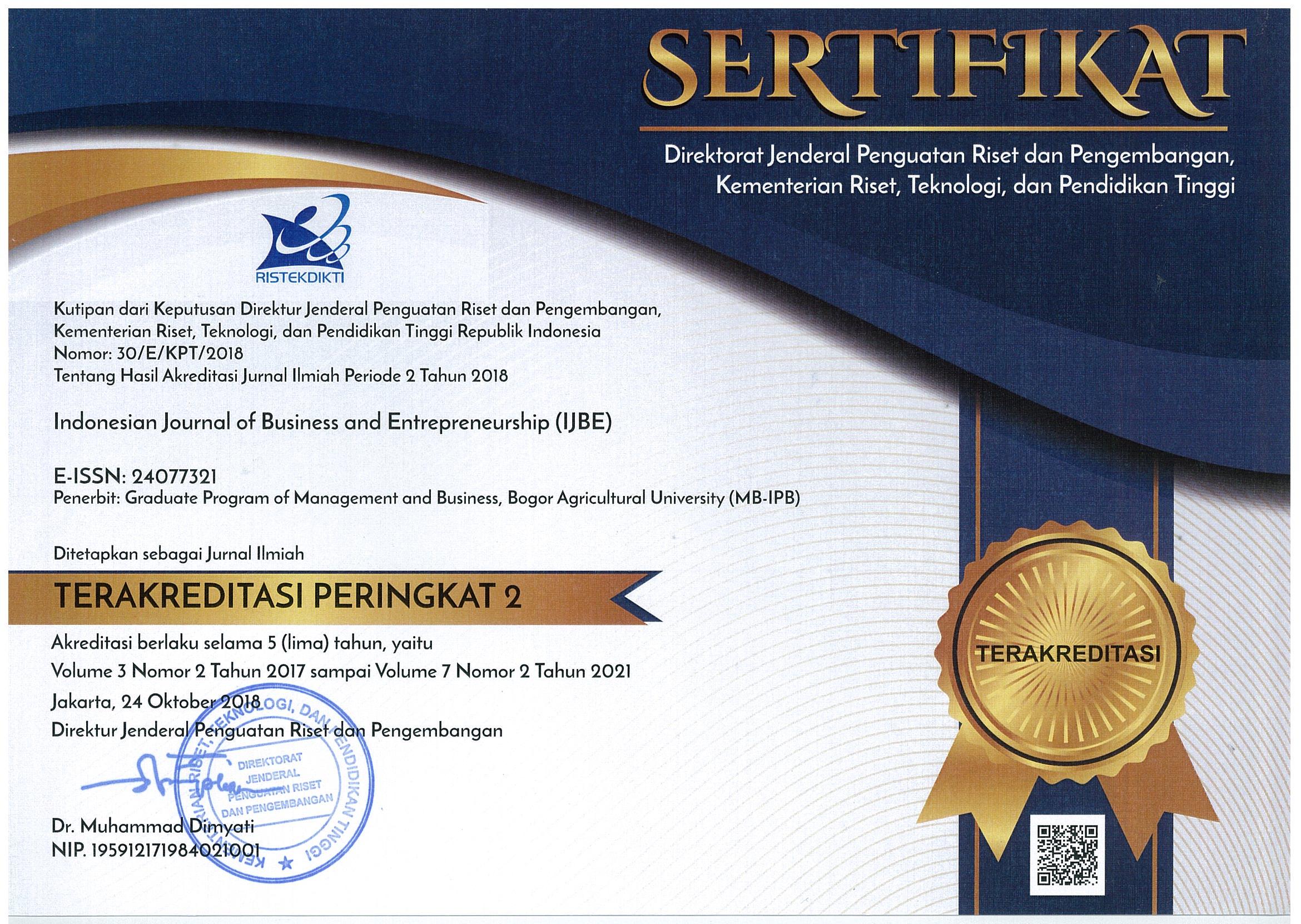Behavioral Intention Analysis on Internet Banking Usage at Bank XYZ Bogor
Abstract
The aims of this paper were to analyze the customer decision to use internet banking and to anlyze the factors correlated with the intention of internet banking usage at XYZ Bank, Bogor, Indonesia. The theoretical foundation for this study was Theory of Planned Behavior (TPB). TPB is a model that estimates the consumers’ intention to perform a behavior or action. A number of 150 respondents were selected by convenience sampling method using questionnaires with interviews. The data were analyzed using SEM-PLS. The results showed that perceived behavior control had a significant influence on behavioral intention. Respondents who had higher scores of perceived behavior were more likely to have a higher intention of using internet banking. For the managerial implications, the company is expected to provide more user-friendly and attractive facilities for users, so that users can easily do banking transactions without having to queue at either a Bank or ATM counters. Second, the facility with more limit than that exists now can be used as a reference for the company to increase the number of internet banking users, so users can use facilities safely, and desired facilities are available in internet banking.
Keywords: behaviour intention, internet banking, SEM-PLS, theory of planned behavior
Downloads
References
Aderonke A. 2010. An empirical investigation of the level of users’ acceptance of e-banking in Nigeria. Journal of Internet Banking and Commerce 1(15): 1–13.
Ahmad M, Kadir AS, Salehudin AN. 2013. Perceptions and behavior’s of muslims and non-muslimstowards halal products. Journal of Social and Development Sciences 4(6): 249–257.
Akhlaq A, Ahmed E. 2013. The effect of motivation on trust in the acceptance of internet banking in a low income country. International Journal of Bank Marketing 31(2): 1–12. https://doi.org/10.1108/02652321311298690.
Alnsour MS. 2011. Internet banking and jordanian corporate customers: issues of security and trust. Journal of Internet Banking and Commerce 16(1): 1–15.
Amalia M, Mudjahidin, Anggraeni W. 2012. Analisis faktor penyebab kepuasan pelanggan terhadap penggunaan internet banking berdasarkan efek pengalaman dengan metode partial least square [studi kasus: Bank Swasta dan Bank BUMN]. Jurnal Teknik Pomits 1(1): 1–6.
Anggraeni NMS, Yasa NNK. 2012. E-service quality terhadap kepuasan dan loyalitas pelanggan dalam penggunaan internet banking. Jurnal Keuangan dan Perbankan 16(2): 293–306.
Aviliani, Sumarwan U, Sugema I, dan Saefudin A. 2011. Segmentasi nasabah tabungan mikro berdasarkan recency, frequency, dan monetary: kasus bank BRI. Finance and Banking Journal 13(1): 95–109.
Baraghani SN. 2007. Factors influencing the adoption of internet banking [tesis]. Lulea: Lulea University of Technology.
Butar-Butar R. 2013. Analisis tingkat kepuasan nasabah terhadap pelayanan produk internet banking di bank Danamon [tesis]. Bogor:Sekolah Pascasarjana Institut Pertanian Bogor.
Clemes MD, Gan C, Du J. 2012. The factors impacting on customers’ decisions to adopt internet banking. Banks and Bank Systems 7(3): 1–13.
Damayanti TW. 2012. Changes on Indonesia tax culture,is there aaay? Studies through thoery of planned behaviour. International Refereed Research Journal 3(4): 1–8.
Ghozali I. 2008. Structural Equation Modeling Metode Alternatif dengan Partial Least Square (PLS). Semarang: UNDIP.
Haryono T, Sumarwan U, Saefuddin A, Hartoyo. 2012. Structural model of factors influencing consumers intention to use natural gas: an application of planned behaviour theory. Journal of Educational Research and Review 1(10): 244–252.
Hidayati NA. 2013. Pengaruh sikap, kontrol perilaku persepsian, pengalaman dan kepercayaan terhadap minatmenggunakan layanan internet banking. Jurnal Ilmiah FEB 2(2): 1–24.
Huda AN, Wahyuni S. 2012. Analisis pengaruh kualitas layanan internet banking dan tingkat kepuasan terhadap loyalitas nasabah pada PT Bank Rakyat Indonesia (Persero) Tbk kantor cabang pembantu Jamsostek Jakarta. Business and Management Review 2(2):1–12.
Kassim NM, Abdulla AKMA. 2006. The influence of attraction on internet banking: an extension to the trust-relationship commitment model. International Journal of Bank Marketing 24(6): 1–20.
Knabe A. 2009. Applying Ajzen's Theory of Planned Behavior to a Study of Online Course Adoption in Public Relations Education. Milwaukee: Marquette University.
Maenpaa K. 2010. User perceptions of internet banking [disertasi].Tampere: University of Tampere.
Makokha LW. 2012. Evaluating Behavioural Intentions In The Adoption Of Internet Banking. Nairobi: University of Nairobi.
Manalu ASB, Sumarwan U And Suroso AI. 2007. Analisis faktor-faktor yang mempengaruhi kepuasan pelanggan online. Jurnal Manajemen dan Agribisnis 4(2): 67–80.
Mayasari F, Kurniawati EP, Nugroho PI. 2011. Anteseden dan konsekuen sikap nasabah dalam menggunakan internet banking dengan menggunakan kerangka Technology Acceptance Model (TAM) (survey pada pengguna klik BCA). Dalam Seminar Nasional Teknologi Informasi &Komunikasi Terapan; 2011, Seminar Nasional, down load internet Maret 2016 URI:http://eprints.dinus.ac.id/id/eprint/23.
Molapo MN. 2008. An assesment of internet banking service quality [disertasi]. Johannesburg: University of Johannesburg.
Nasri W. 2011. Factors influencing the adoption of internet banking in Tunisia. International Journal of Business and Management 6(8): 1–13. https://doi.org/10.5539/ijbm.v6n8p143.
Rismanto, Wiyono A, Wachyuni S. 2013. Kajian peran rerta petani dalam operasi dan pemeliharaan infrastruktur jaringan irigasi dengan pendekatan Theory of Planned Behaviour (TPB). Jurnal Sosioteknologi 30(12): 1–25.
Rogers M. 2010. Consumers attitudes perceived risk, trust and internet banking adoption in Uganda [disertasi]. Kampala: Makerere University.
Saleh ZI. 2003. An Examination of The Internet Security And Its Impact on Trust And Adoption of Online Banking. Minneapolis:Capella University.
Sanjaya R, Sumarwan U, Kirbrandoko. 2015. Hubungan customer relationship management dengan loyalitas nasabah (Studi kasus: PT Bank XYZ Cabang Bogor. Manajemen IKM 10(2): 151–162.
Sulistiyarini S. 2013. Pengaruh minat individu terhadap penggunaan mobile banking: model kombinasi technology acceptance model (TAM) dan theory of planned behaviour (TPB). Jurnal Ilmiah FEB 1(2): 1–20.
Sumarwan U. 2011. Perilaku Konsumen Teori dan Penerapannya dalam Pemasaran. Ed ke-2.Bogor: Penerbit Ghalia Indonesia.
Tan M, Teo TSH. 2000. Factors influencing the adoption of internet banking. Journal of the Association for Information Systems1(2): 1–44. https://doi.org/10.17705/1jais.00005.
Widiastuti B. 2010. Studi tentang intensitas penggunaan electronic banking oleh nasabah PT Bank Central Asia,Tbk (BCA) kantor cabang utama Semarang [tesis]. Semarang: Universitas Diponegoro.







